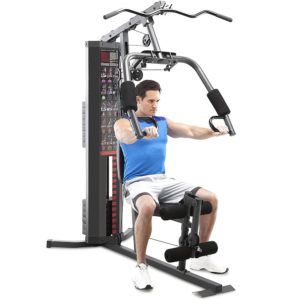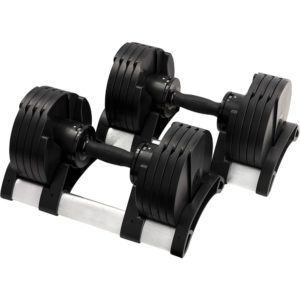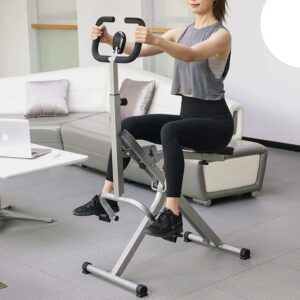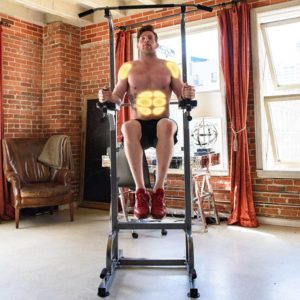Home Strength Training Equipment
3 DAY MAY SUPER SALE … Don’t Miss Out
-
Sale!

Home Gym | Multifunctional Stack Home Gym Station | Multi Function Gym For Home
Original price was: $1,349.$1,106Current price is: $1,106. -
Sale!

Portable Home Gym Workout Equipment | Full Body Workout System | Portable Exercise Equipment
Original price was: $293.$233Current price is: $233. -
Sale!

Adjustable Weight Bench | Incline Decline Bench | Gym Weight Bench
Original price was: $469.$343Current price is: $343. -
Sale!

Adjustable Dumbbell Weight Set | Adjustable Weights | Dumb Bells
Original price was: $639.$559Current price is: $559. -
Sale!

Fitness Squat Assist | Glute Trainer Machine | Squat Machine
Original price was: $279.$229Current price is: $229. -
Sale!

Body Dip Station | Pull Up Bar Station | Dip Bar
Original price was: $489.$413Current price is: $413.
How to Get a Full-Body Strength Training Workout at Home
Strength training, also called weight training or resistance training, is an important part of any fitness routine. It helps make you stronger and also builds muscle endurance.
With strength training, you move your body against some type of resistance, such as:
- your body weight
- free weights, like dumbbells or barbells
- resistance bands, also known as resistance tubing or workout bands
- resistance machines, like cable machines, single-exercise machines, or multi-gym systems
Strength training is a versatile type of workout that you can do almost anywhere. While it’s a popular exercise option at many gyms, you can also build a robust strength training program that you can do in the comfort and privacy of your home.
What are the benefits of strength training?
Research has shown that strength training can benefit your health and fitness in many different ways. According to the Mayo Clinic, strength training may help:
- build lean muscle mass
- reduce body fat
- burn calories more efficiently, even after you’ve exercised
- boost metabolism and make weight loss easier
- increase bone density and improve bone health
- boost flexibility and improve range of motion
- improve brain health and cognitive functions
- reduce the symptoms of many chronic conditions, including back pain, diabetes, arthritis, and heart disease
- improve posture, balance, and stability
- raise energy levels
- improve mood and overall sense of well-being
What are the benefits of working out at home?
A home-based exercise routine can be a super easy and convenient way of fitting in a workout without having to hit the gym.
Benefits
- It saves time. There’s no traveling or waiting for machines or equipment.
- It’s low cost. There are no gym fees or expensive equipment needed.
- Work out anytime. You can exercise on your own schedule, no matter the time of day or night.
- Privacy. You can work out without feeling self-conscious.
- Go at your own pace. There’s no pressure to keep up with those around you or to push yourself beyond what’s comfortable.
Getting started
Once you’re ready to start putting together your strength training workout, the first step is to find a place in your home where you can exercise comfortably. You’ll want to find an area that has enough room for you to move your arms and legs freely.
You don’t need to invest in much equipment, but if you do want to purchase a few items, here are some that may be helpful:
- an exercise mat
- resistance bands or tubing
- dumbbells
- a kettlebell
- a stability ball
- a medicine ball
Instead of using dumbbells or a kettlebell, you can improvise by using water bottles, sandbags, or canned goods in place of the weights.
If you’re just getting started with strength training, you may want to find a strength training workout for beginners online. This can help you learn how to do different exercises with the right form, and also warm up and cool down correctly.
Start with a warmup
Before starting your workout, do a warmup routine for at least 5 to 10 minutes. This can include brisk walking, jogging on the spot, or movements that work your legs, arms, and other major muscle groups.
Bodyweight strength training exercises
Once your muscles are warmed up and ready to move, you can start by doing a series of bodyweight exercises.
You don’t need any equipment for bodyweight exercises, except an exercise mat if the floor is too hard.
With each of these exercises, use smooth, steady, and controlled movements.
Lunges
A basic lunge works the muscles in your lower body, including your quadriceps, hamstrings, glutes, and calves.
To do this exercise:
- Start by standing up tall, feet shoulder-width apart.
- Step forward with your right foot, and lower your hips toward the floor until your right leg is at a 90-degree angle and your left knee is parallel to the ground. Make sure your front knee doesn’t go beyond your toes.
- Lengthen your spine to keep your torso upright.
- Hold this position for 5 seconds or longer.
- Then step your right foot back to meet your left, and repeat this movement with your left leg.
- Repeat 10 to 12 times, then rest briefly and do another set.
- Lunge variations include walking lunges, jumping lunges, lunges with a torso twist, and side lunges.
Squat to overhead raise
If you’re new to strength training, start off by raising your arms overhead without any weight. Once you can do this exercise with good form, you can add light dumbbells, and increase the weight as you build strength.
This exercise not only works your glutes and leg muscles, it also works the muscles in your core, back, and shoulders, as well as your triceps.
To do this exercise:
- Stand with your feet slightly wider than your hips and your arms alongside your body.
- Slowly lower your hips down into a squat position.
- Press up to come back into standing and raise your arms overhead.
- Return to the starting position.
- Do 1–3 sets of 8–12 repetitions.
Planks
Planks are an excellent exercise for improving your core strength and stability. This exercise can also strengthen the muscles in your back, chest, and shoulders.
To do this exercise:
- Rest on your forearms and toes only, keeping your body in a straight line with your buttocks clenched and your abdominal muscles engaged.
- Try to hold this position for 30 seconds. If that’s too hard, start with 20 seconds.
- As you gain strength and fitness, try to hold the plank position for 1 minute or longer.
- Once you’re ready for a more challenging version of the plank, you can try lifting one leg at a time while you’re holding the plank position.
Pushups
Standard pushups work the chest muscles (pectorals), as well as the shoulder muscles, triceps, and abdominals.
To do this exercise:
- Start in a plank position with your palms directly under your shoulders.
- Keeping your back flat and bracing your core, lower your body by bending your elbows until your chest almost touches the floor.
- Immediately push your body back up to the starting position.
- Repeat 8–12 times. Start with 1–2 sets, and build up to 3 sets as you get stronger.
- A less challenging version of the pushup can be done by putting your weight on your knees instead of your toes.
More challenging pushup variations include plyo pushups, close stance pushups, and decline pushups.
Free weight exercises
The following two exercises use dumbbells. Start with a 5-pound dumbbells. As you build up your strength, you can switch to using 8- or 10-pound dumbbells.
You can also use canned goods or water bottles in place of dumbbells. Just be sure to grip them firmly to avoid injury.
Dumbbell shoulder press
This exercise targets the muscles in your shoulders and arms, and can also strengthen your core and chest muscles.
To do this exercise:
- Stand with your feet shoulder-width apart.
- Pick up the dumbbells and raise them to shoulder height. Your palms can face forward or toward your body.
- Raise the dumbbells above your head until your arms are fully extended.
- Pause in this position for a few seconds, and then bring the dumbbells back to shoulder height.
- Do 1–3 sets of 8–12 repetitions.
Dumbbell triceps kickback
This exercise works your triceps as well as your shoulder muscles.
To do this exercise:
- Grab two dumbbells and hold one in each hand.
- Bend your torso at a 45-degree angle, and bend your elbows so they form a 90-degree angle.
- Then straighten your arms out directly behind you, engaging your triceps as you go.
- You can either do one arm at a time, or both together.
- If you’re a beginner, start with 1–2 sets of 8–12 reps, and build up to 3 sets as you get stronger.
Resistance band exercises
Resistance bands are another great tool for your strength training workout. They’re lightweight and versatile, and a 2010 studyTrusted Source has shown they work your muscles just as well as free weights or weight machines.
Resistance band pull apart
This exercise works the muscles in your back, shoulders, and arms.
To do this exercise:
- Stand with your arms extended out in front of you at chest height.
- Hold a resistance band tautly with both hands. The band should be parallel to the ground.
- Keeping your arms straight, pull the band toward your chest by moving your arms outward to your sides. Initiate this movement from your mid-back.
- Squeeze your shoulder blades together, and keep your spine straight, then slowly return to the starting position.
- Do 1–3 sets of 15–20 reps.
Hip extension
This exercise works the muscles in your hips and legs.
You’ll need a light- to medium-resistance band to do this exercise.
- Loop the resistance band around both your ankles. You can use a chair or wall for balance.
- Keeping a straight line in your body, pull your left leg back as far as you can, keeping it as straight as possible.
- Slowly return to the starting position.
- Complete 12 reps with your left leg, then repeat with your right leg.
- Complete 2 sets on each side to start, and work up to doing 3 sets as you build up your strength.
Resistance band leg press
This exercise works your quadriceps, hamstrings, calves, and glutes. Like a leg press on a weight machine, this exercise makes you work against gravity.
- Lie on your back and lift your feet off the ground.
- Bend your knees, creating a 90-degree angle. Flex your feet, pointing your toes upward.
- Wrap the resistance band around your feet and hold the ends.
- Press your feet against the bands until your legs are fully extended.
- Bend your knees to return to a 90-degree angle.
- Do 1–3 sets of 10–12 reps.
How to cool down
Finish your workout by cooling down for about 5 to 10 minutes. This allows your breathing and heart rate to transition into a resting state. Options include walking on the spot and gentle stretches.
The bottom line
Doing 30 to 45 minutes of strength training two to three times a week is an excellent way of building lean muscle mass, burning calories, and boosting your metabolism. This, in turn, can help you burn body fat and make weight loss easier.
In addition, strength training can strengthen your bones and joints, lower your risk of chronic diseases, improve flexibility, posture, and balance, and boost your mood and energy levels.
Many strength training exercises can be done in the comfort and privacy of your home, using just your body weight or basic, low-cost equipment as resistance.
If you have any health concerns or an injury that makes exercising difficult, talk to your doctor or a certified personal trainer before you start an at-home strength training routine.
